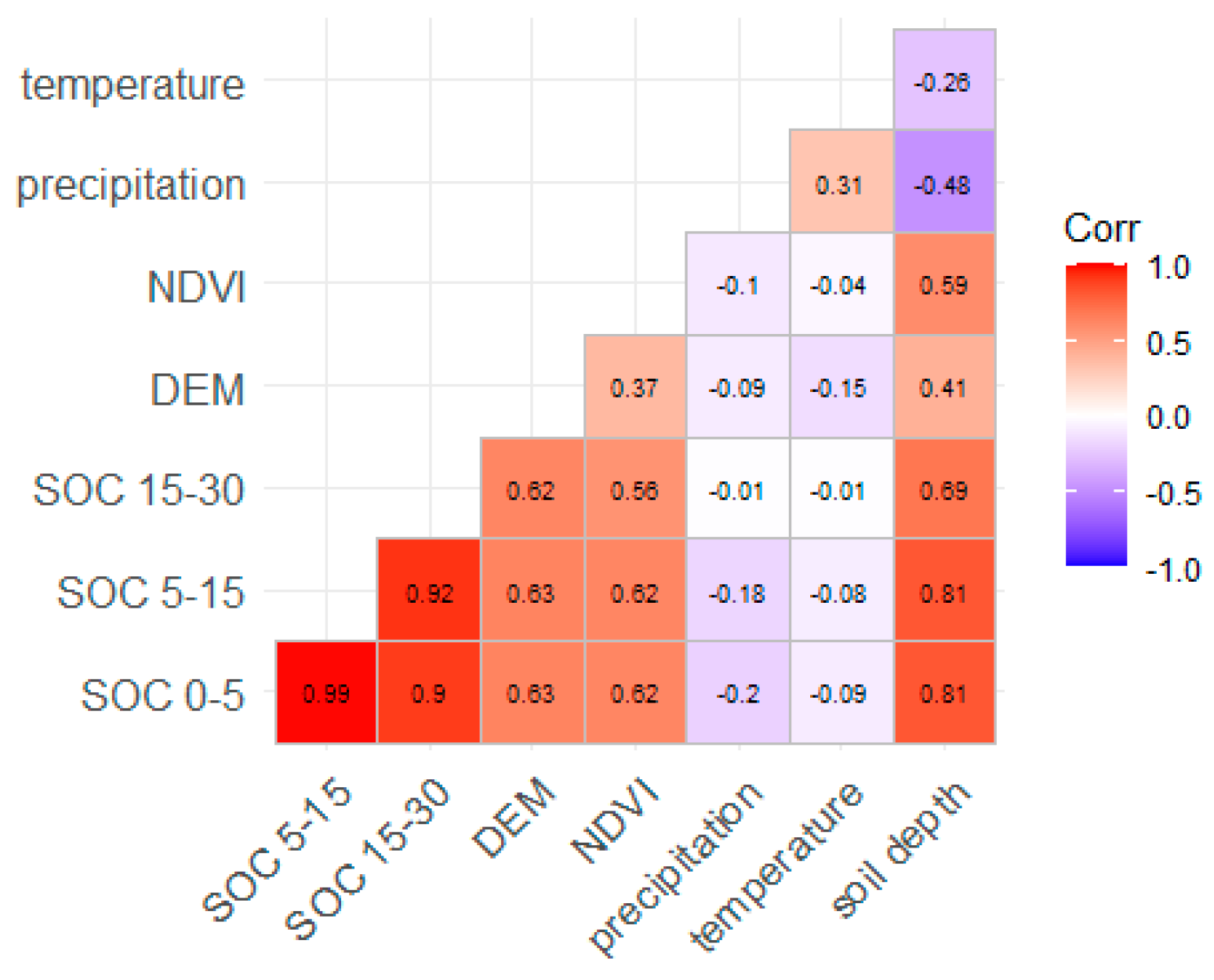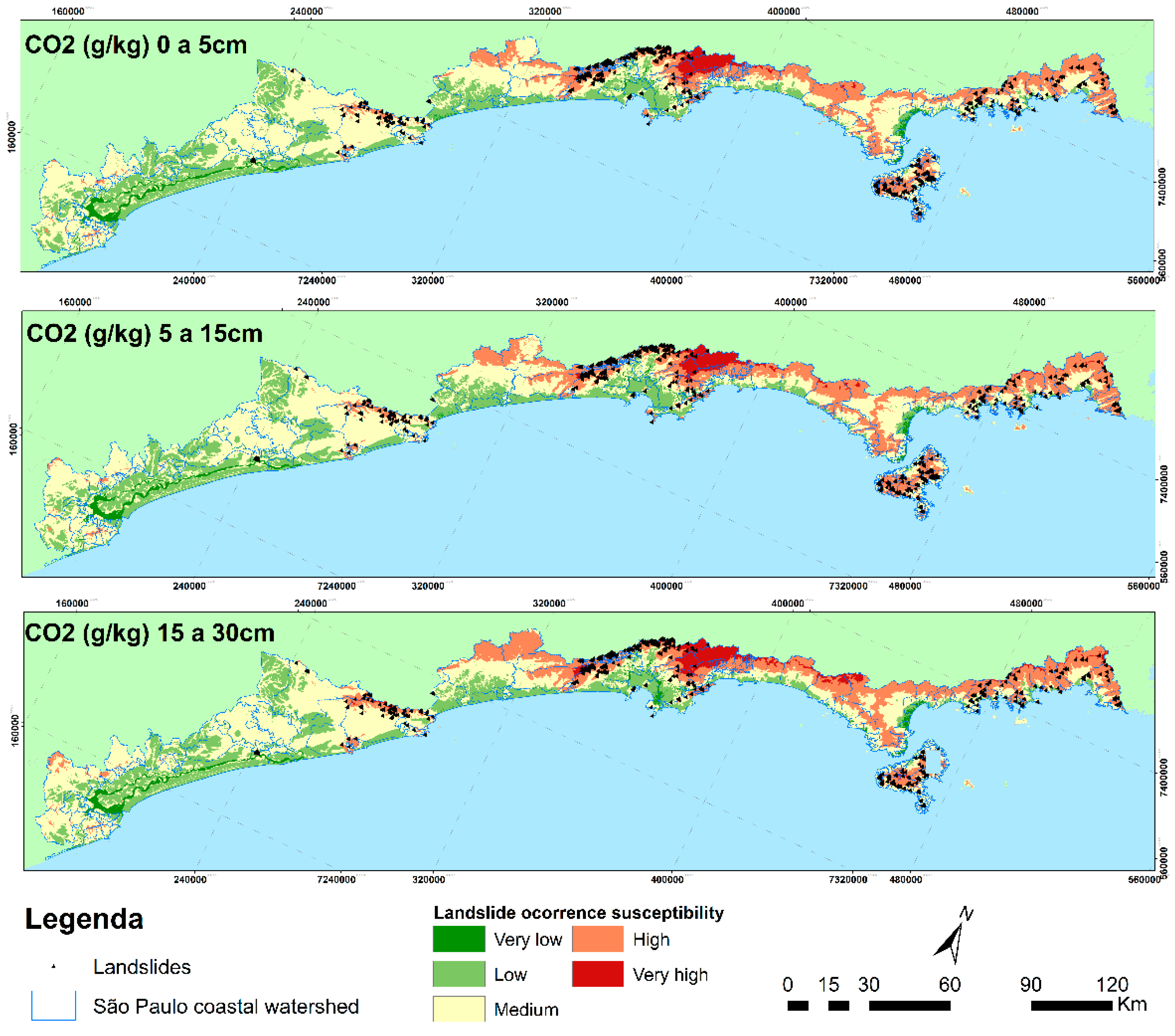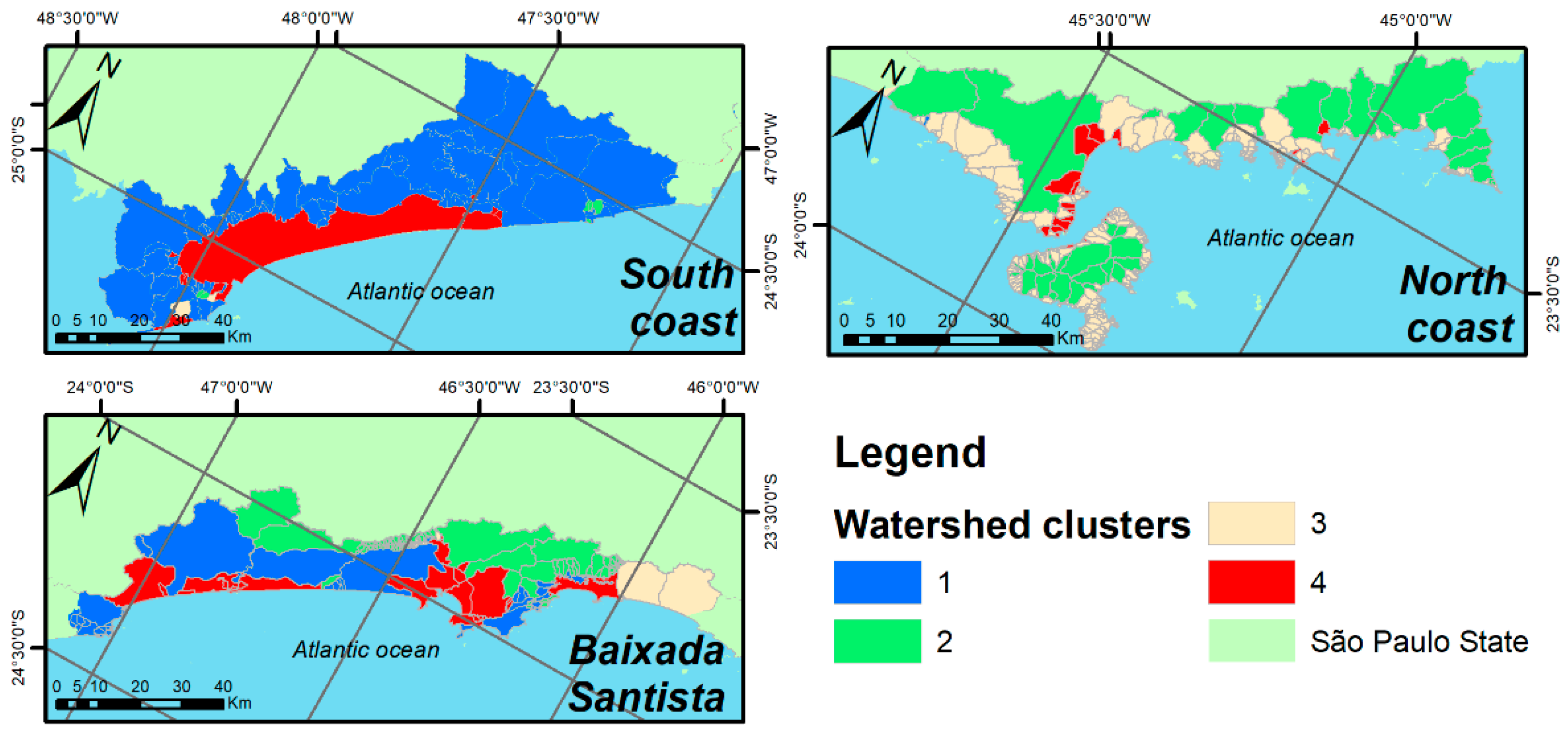Ecohydrological Analysis in Watersheds of Mountain Areas of São Paulo State Coastal, Brazil †
Abstract
:1. Introduction
2. Materials and Methods
- -
- Normalized Difference Vegetation Index (NDVI): using LANDSAT image from 2016 available in the United States Geological Survey (USGS). The NDVI has been used in ecohydrological assessments in previous research [4,5,6]. Because the NDVI is a satellite with a medium spatial resolution and is appropriate for research on a regional scale, we used it in our study [7,8,9]. The images were processed using the ArcGIS Raster Calculator tool, and were then used to generate NDVI images;
- -
- Digital terrain model (DTM): topographic maps from Brazilian Institute of Geography and Statistics (IBGE, Portuguese acronym) and the Topo to Raster interpolation tool were used in ArcGIS [10];
- -
- -
- Climate data: data from average of total annual precipitation from 2006 to 2015 (source: National Water Agency—ANA, Portuguese acronym) and average of temperature from 2006 to 2015 (source: National Institute for Space Research—INPE, Portuguese acronym) interpolated using the IDW tool;
- -
3. Results and Discussion
4. Conclusions
Author Contributions
Funding
Institutional Review Board Statement
Informed Consent Statement
Data Availability Statement
Conflicts of Interest
References
- Dunbar, M.J.; Acreman, M.C. Applied Hidro-Ecological Science for Twenty-First Century. In Hydro-Ecology: Linking Hydrology and Aquatic Ecology; Acreman, M.C., Ed.; IAHS Publication n 266; IAHS Press: Wallingford, UK, 2001; pp. 1–17. [Google Scholar]
- Zalewski, M.; Robarts, R. Ecohydrology—A New Paradigm for Integrated Water Resources Management. Sil News 2003, 40, 1–5. [Google Scholar]
- Bonell, M. Ecohydrology—A Completely New Ideia? Hydrol. Sci. J. 2002, 809–810. [Google Scholar] [CrossRef]
- Band, L.E.; Hwang, T.; Hales, T.C.; Vose, J.; Ford, C. Ecosystem Processes at the Watershed Scale: Mapping and Modeling Ecohydrological Controls of Landslides. Geomorphology 2012, 137, 159–167. [Google Scholar] [CrossRef]
- Zhang, S.; Ye, Z.; Chen, Y.; Xu, Y. Vegetation Responses to an Ecological Water Conveyance Project in the Lower Reaches of the Heihe River Basin. Ecohydrology 2017, 10, e1866. [Google Scholar] [CrossRef]
- Ruiz-Pérez, G.; Koch, J.; Manfreda, S.; Caylor, K.; Francés, F. Calibration of a parsimonious distributed ecohydrological daily model in a data-scarce basin by exclusively using the spatio-temporal variation of NDVI. Hydrol. Earth Syst. Sci. 2017, 21, 6235–6251. [Google Scholar] [CrossRef]
- Sánchez, J.M.; Scavone, G.; Caselles, V.; Valor, E.; Copertino, V.A.; Telesca, V. Monitoring Daily Evapotranspiration at a Regional Scale from Landsat-TM and ETM+ Data: Application to the Basilicata Region. J. Hydrol. 2008, 351, 58–70. [Google Scholar] [CrossRef]
- Xu, D.; Kang, X.; Qiu, D.; Zhuang, D.; Pan, J. Quantitative Assessment of Desertification Using Landsat Data on a Regional Scale—A Case Study in the Ordos Plateau, China. Sensors 2009, 9, 1738. [Google Scholar] [CrossRef] [PubMed]
- Kloiber, S.M.; Brezonik, P.L.; Bauer, M.E. Application of Landsat Imagery to Regional-Scale Assessments of Lake Clarity. Water Res. 2002, 36, 4330–4340. [Google Scholar] [CrossRef] [PubMed]
- Christofoletti, A.; Perez Filho, A.P. Estudos Sobre a Forma de Bacias Hidrográficas. Bol. Geogr. Teorética 1975, 5, 63–82. [Google Scholar]
- Rossi, M. (Ed.) Mapa Pedológico Do Estado de São Paulo: Revisado e Ampliado; Secretaria do Meio Ambiente, Instituto Florestal: São Paulo, Brazil, 2017. [Google Scholar]
- Vasques, G.M.; Coelho, M.R.; Dart, R.O.; Cintra, L.C.; Baca, J.F.M.; MendonçaSantos, M.L. Soil Organic Carbon Stock Maps for Brazil at 0–5, 5–15, 15–30, 30–60, 60–100 and 100–200 cm Depth Intervals with 90 m Spatial Resolution. Version 2021. Embrapa Solos, Rio de Janeiro, Brazil. 2021. Available online: http://geoinfo.cnps.embrapa.br/documents/3275 (accessed on 30 May 2022).
- Horn, R. Aggregate Characterization as Compared to Soil Bulk Properties. Soil Tillage Res. 1990, 17, 265–289. [Google Scholar] [CrossRef]
- Soane, B.D. The Role of Organic Matter in Soil Compactability: A Review of Some Practical Aspects. Soil Tillage Res. 1990, 16, 179–201. [Google Scholar] [CrossRef]
- Ab’Saber, A.A.; Ab’Saber, A.A. Contribuição à Geomorfologia Do Litoral Paulista. Rev. Bras. Geogr. 1955, 17, 3–48. [Google Scholar]






| ID Region | Region | ID Municipality | Municipality | ID Region | Region | ID Municipality | Municipality |
|---|---|---|---|---|---|---|---|
| 1 | South coast | 1 | Cananéia | 2 | Baixada Santista | 9 | Cubatão |
| 2 | Iguape | 10 | Santos | ||||
| 3 | Ilha Comprida | 11 | Guarujá | ||||
| 2 | Baixada Santista | 4 | Peruíbe | 12 | Bertioga | ||
| 5 | Itanhaém | 3 | North coast | 13 | São Sebastião | ||
| 6 | Mongaguá | 14 | Ilhabela | ||||
| 7 | Praia Grande | 15 | Caraguatatuba | ||||
| 8 | São Vicente | 16 | Ubatuba |
| Soil Depth | Weights | |
|---|---|---|
| very shallow soils | <50 cm | 10 |
| shallow soils | 50–100 cm | 7.25 |
| deep soils | 100–200 cm | 3.5 |
| very deep soils | >200 cm | 1 |
| CO2 (g/kg) 0–5 cm | CO2 (g/kg) 5–15 cm | CO2 (g/kg) 15–30 cm | ||||
|---|---|---|---|---|---|---|
| Landslide Frequency | % | Landslide Frequency | % | Landslide Frequency | % | |
| Very low | 0 | 0 | 0 | 0 | 0 | 0 |
| Low | 6 | 1.15 | 5 | 0.95 | 4 | 0.76 |
| Medium | 108 | 20.61 | 80 | 15.27 | 86 | 16.41 |
| High | 360 | 68.7 | 387 | 73.85 | 315 | 60.11 |
| Very high | 50 | 9.54 | 52 | 9.92 | 119 | 22.71 |
| 524 | 100 | 524 | 100 | 524 | 100 | |
| Cluster | 1 | 2 | 3 | 4 | ||||
|---|---|---|---|---|---|---|---|---|
| Tw | wLr | Tw | wLr | Tw | wLr | Tw | wLr | |
| SOC (0–5 cm) | 23.071 | 23.455 | 29.655 | 29.009 | 26.379 | 26.535 | 19.615 | 20.212 |
| SOC (5–15 cm) | 22.856 | 23.207 | 29.154 | 28.562 | 25.830 | 25.998 | 19.396 | 19.859 |
| SOC (15–30 cm) | 23.529 | 23.842 | 30.727 | 30.050 | 25.485 | 26.093 | 19.546 | 19.541 |
| DTM | 88.531 | 87.126 | 358.566 | 418.320 | 160.645 | 218.605 | 49.451 | 39.163 |
| NDVI | 0.817 | 0.760 | 0.850 | 0.846 | 0.830 | 0.824 | 0.557 | 0.569 |
| Precipitation | 1815.318 | 1745.113 | 1654.509 | 1562.001 | 1414.248 | 1403.654 | 1617.856 | 1687.321 |
| Temperature | 23.573 | 24.071 | 23.170 | 22.952 | 22.905 | 22.826 | 23.105 | 23.064 |
| Soil depth | 5.394 | 5.778 | 8.254 | 8.200 | 8.193 | 7.764 | 3.507 | 3.558 |
| Landslide occurrence | 0.961 | 6.421 | 2.140 | 6.652 | 0.160 | 2.069 | 0.405 | 3.333 |
| Watershed amount | 127 | 19 | 143 | 46 | 375 | 29 | 74 | 9 |
Disclaimer/Publisher’s Note: The statements, opinions and data contained in all publications are solely those of the individual author(s) and contributor(s) and not of MDPI and/or the editor(s). MDPI and/or the editor(s) disclaim responsibility for any injury to people or property resulting from any ideas, methods, instructions or products referred to in the content. |
© 2022 by the authors. Licensee MDPI, Basel, Switzerland. This article is an open access article distributed under the terms and conditions of the Creative Commons Attribution (CC BY) license (https://creativecommons.org/licenses/by/4.0/).
Share and Cite
Folharini, S.; Vieira, A.; de Oliveira, R.C. Ecohydrological Analysis in Watersheds of Mountain Areas of São Paulo State Coastal, Brazil. Proceedings 2023, 87, 32. https://doi.org/10.3390/IECG2022-13864
Folharini S, Vieira A, de Oliveira RC. Ecohydrological Analysis in Watersheds of Mountain Areas of São Paulo State Coastal, Brazil. Proceedings. 2023; 87(1):32. https://doi.org/10.3390/IECG2022-13864
Chicago/Turabian StyleFolharini, Saulo, António Vieira, and Regina Célia de Oliveira. 2023. "Ecohydrological Analysis in Watersheds of Mountain Areas of São Paulo State Coastal, Brazil" Proceedings 87, no. 1: 32. https://doi.org/10.3390/IECG2022-13864
APA StyleFolharini, S., Vieira, A., & de Oliveira, R. C. (2023). Ecohydrological Analysis in Watersheds of Mountain Areas of São Paulo State Coastal, Brazil. Proceedings, 87(1), 32. https://doi.org/10.3390/IECG2022-13864








